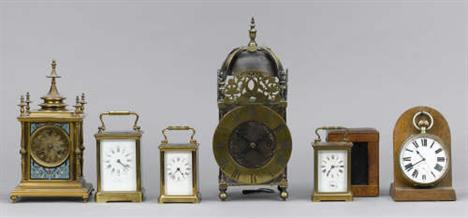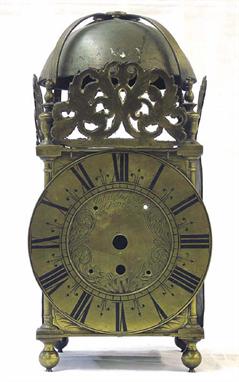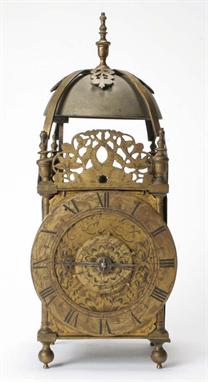A Brass Lantern Clock, signed Edward Stanton, London, circa 1695, 6-1/2-inch chapter ring with engraved floral dial centre, single steel hand and central alarm disc, the posted movement with "later" conversion to anchor escapement, countwheel striking, the case with slender tapered corner columns, turned feet, turned finials and pierced frets, top mounted bell, iron back and spurs (missing), 40cm high (later alterations) See illustration
We found 4372 price guide item(s) matching your search
There are 4372 lots that match your search criteria. Subscribe now to get instant access to the full price guide service.
Click here to subscribe- List
- Grid
-
4372 item(s)/page
A Victorian brass lantern clock Unsigned, late 19th century The twin fusee movement with anchor escapement within a posted frame, with a scroll engraved dial applied with a Roman numeral chapter ring with fleur de lys half hour markers beneath armorial frets and bell supported within the domed bearer above, on turned brass feet, 37cm high.
A BRASS CASED LANTERN CLOCK, the dial signed "John Ebsworth at ye in Sothbury, Londini, Fecit", the dial with Roman numerals decorated with a border of foliate engraving, with a birdcage type movement within four tapering columns, with bell above surrounded by dolphin pierced mounts, on turned ball feet, 15" high
CLOCKS: FIVE REFERENCE BOOKS; Clutton C., and Daniels G., Clocks & Watches, pub. 1980;, Edwardes, E.L., The Story of the Pendulum Clock pub. 1977; Hana, W.F.J., English Lantern Clocks pub. 1979; Good, R., Victorian Clocks, pub. 1996; and exhibition catalogue, Horological Masterworks, English Seventeenth-Century Clocks from Private Collections, Museum of the History of Science Oxford. (5)
A brass lantern clock, Part late 17th century The two-train countwheel bell-striking movement with anchor escapement, the foliate engraved dial bearing signature Joseph Knibb Londini Fecit within a narrow silvered Roman numeral chapter ring with sceptre half hour markers, with turned columnar posts to frame and dolphin frets beneath bell contained within four-arm cage above, the rear with iron backplate, hanging hoop and spurs, wheelwork late 17th century, frame and dial later, 39cm high.
A Cromwellian brass lantern clock, the verge escapement striking on a bell within a hook and spike pillared frame, to a 6.25in (16.5cm) chapter ring, the rose and tulip engraved centre inscribed 'Thomas Knifton at the 'Crossed Keys' in Lothbury Londini,' with a single hand, the case with urn finials and pierced shield and foliage crestings and turned feet, 15in (38cm) high.
A rare George II walnut large bracket clock Windmills & Wightman, London, circa 1735 The five-pillar twin fusee rack and bell striking movement with verge escapement, rise/fall regulation and Hoho bird inhabited foliate engraved backplate signed Windmills & Wightman, LONDON within a circular cartouche to centre, the 12 inch brass break-arch dial with false bob and calendar apertures and arched signature plaque to the matted centre, within an applied silvered Roman numeral chapter ring with Arabic five minutes and fleur de lys half hour markers, with female mask and scroll cast spandrel applied angles beneath rise/fall regulation dial between dolphin cast mounts to arch, the case with later inverted bell top and foliate pierced frets above husk and scroll carved canted angles with conforming frets and brass handles to sides, on cavetto moulded base with shaped apron, 74cm high. The exact date on which William Wightman joined the celebrated Windmills firm is uncertain however Ordnance Office bills record the partnership in September 1735 (see Neale, J.A. Joseph and Thomas Windmills, Clock and Watch Makers 1671-1737, p.233). Five longcase clocks are recorded by Neale but no bracket, lantern clocks or watches are noted. The reason why this unusually large clock was made is uncertain however another ebonised example (a timepiece with silent pull repeat signed Windmills) is described by Neale and a walnut clock of similar proportions but with a rectangular dial by George Graham was formerly in the Iden collection. It is probable that such clocks were utilised in a semi-public context where the use of a longcase clock would be problematic.
A Victorian cast iron and brass quarter striking turret clock J. Smith and Son, Derby, circa 1860 Of flat-bed construction with six-spoke wheel crossings, brass bushed pivots and lantern pinions, the central going train with pin-wheel escapement, maintaining power, and wood-rod pendulum, flanked by hour strike with pinned countwheel opposing the quarter train, on rectangular open bed frame applied with plaque signed J. SMITH & SONS, MIDLAND CLOCK WORKS, DERBY with integral splayed feet, on later wood stand with take-off work for four dials, bell mounting brackets and other accesories, frame 107cm wide John Smith is recorded in Loomes, Brian Watchmakers & Clockmakers of the World Volume 2 as working in Derby from 1855-76.
INTERESTING ANTIQUE WING LANTERN CLOCK, the posted movement with single hand, verge escapement, alarm and outside countwheel, the 7.25" chapter ring signed John Davis, Windsor, the brass case with finely turned corner pillars, urn finials, floral fretwork panels and ball feet, 14.5" high (wings replaced)
A brass lantern clock, the anchor escapement striking on a bell, within a posted frame with hook and spikes, to a 7in arched brass dial with single hand and silvered chapter ring, the boss inscribed 'Debenham, Long Melford', 15in (38cm) h. The doors and back panel have been cut from an early 18th century dial.
A late 17th century English lantern clock with foliate scroll pierced pediment, inscribed "Tho Powell 1689" above an urn and floral engraved dial with 9" chapter ring set with Roman numerals and trident half hour divisions, the domed main bell above eight graduated smaller bells being struck by eleven hammers, crown wheel with short pendulum and three train verge escapement musical movement played by an 11 cm barrel, the movement supported by four turned uprights and raised on four squat turned supports, overall height 41 cm (Also included in this lot is an associated 17th century embossed clock plate centred with a crown and flanked by angels (ILLUSTRATED)
A French ormolu and champleve enamel mantel clock, the circular matt gilt dial with Roman chapter ring, inscribed 'Le Roy & Fils, 67 New Bond St, Made in France' and 'Palais Royal, Paris', eight day movement, striking on a bell, the breakfront arched architectural case beneath a cylindrical lantern with lofty pierced finial, colourfully enamelled throughout with flower sprays on a bright turquoise ground, freestanding pillars to angles and set with putti, 43cm high
An early 20th Century lacquered brass Timepiece, retailed by Mappin & Webb, modelled in the form of a lantern clock, with five balustered finials, supporting a bell, over pierced panels, to a Roman chapter ring and blued steel hands, raised on four ball feet, to a rectangular brass movement with lever platform escapement, height 10”
Stereoscopic interest: a quantity of assorted Premier magic lantern plates, includes Hawkmoth, The Stately Homes of England, Cathedrals, slides of China, paintings and prints, especially Canterbury (quantity) plus a fox-fur stole, a Bulmers cider cold cast woodpecker, 1930's mantel clock, leather suitcase and cake stand.
A brass lantern clock dated (16)82 of posted construction with one-piece cup-and-cover finials posts and tall ball feet the movement now with anchor escapement and countwheel strike on a bell mounted within the dome shaped bearer above the dial with mask and scroll engraved centre within an applied Roman numeral chapter ring with asterisk half hour markers the angles engraved Edward Webb in Chewstoke Fecit 82 with armorial frets replaced iron hand and side doors with pendulum and weights wheelwork extensively restored using contemporary components 39cm high overall Edward Webb is probably the most celebrated of all the 17th century Chew Valley clockmakers the origins of the distinctive and attractive design of this lantern clock can be found in the work of Thomas Browne of Bristol during the reign of Charles I with the design of the dial engraving in particular changing very little during the next two generations of clockmaking in the area. The frame and dial of this clock belong to a series of clocks of which eight other dated examples are known including an example in the Science Museum London dated 1688. See White George The English Lantern Clock p.232
A brass lantern clock circa 1660 of posted construction now with anchor escapement and countwheel strike on a bell mounted within the dome shaped bearer above the dial with alarm disc and signed Thomas Knifton at the (crossed keys) in Lothbury Londini within an applied Roman numeral chapter ring with stylised wheat-ear half hour markers with original iron hand beneath dolphin frets with original side doors alarm removed and movement with 18th century restorations 40cm high Thomas Knifton is recorded in Baillie G.H. Watchmakers & Clockmakers of the World as working in London 1640-62. The dial and frame of this clock typify Knifton’s work and now exhibit an attractive mellow colour the movement originally had balance wheel control but was converted to anchor escapement during a refurbishment in the 18th century
A brass thirty-hour lantern clock the posted countwheel bell-striking movement with anchor escapement and dial bearing signature Abraham Bilbie within an applied Roman numeral chapter ring with sword hilt half hour markers beneath foliate pierced frets and bell within dome shaped bearer above with brass side doors pendulum and weight composite mainly 20th century using 18th century parts 38cm high
An important provincial first period brass lantern clock second quarter of the 17th century of substantial posted construction with cup-and-cover finials and acorn feet the movement now with anchor escapement and countwheel strike on a bell mounted within the dome shaped bearer above the dial with flowerhead mask and repeating floral scroll engraving within an applied Roman numeral chapter ring with cruciform half hour markers with original iron hand beneath heraldic fret signed Elias Browne at Norwich to lower edge with original side doors pendulum and weight alarm removed some restoration 41cm high overall The design and proportion of the frame castings as well as the dial engraving are comparable to the work of William Bowyer of Leadenhall Street London. See Bruce Bill Early English Lantern Clocks 1615-1700 (privately published in 2004) exhibit 2 for a clock attributed to Bowyer. However the detail design of the half hour markers hammer stop and general quality of the frame turnings strongly suggest that this clock originated from the workshop of William Sellwood who is recorded in Baillie G.H. Watchmakers & Clockmakers of the World as working in London 1633-52. Elias Browne of Norwich appears to be unrecorded as a maker however an Edward Browne is recorded as working in the early 18th century. see illustration on front cover
A rare George III miniature pine hooded wall clock case late 18th century with ogee moulded dentil cornice above break-arch door with aperture for 4.5in dial and integral pilasters with cavetto moulded throat and pierced side brackets beneath 39cm high overall. Marks on the internal surface of the backboard suggest that this case was made for a miniature lantern clock with hook and spike hanging. From the collection of the late Mr J Morley
A brass thirty-hour lantern clock the posted countwheel bell-striking movement with 7in brass break-arch dial with matted centre within applied silvered Roman numeral chapter ring and foliate cast spandrels to angles beneath silvered boss engraved with a church flanked by conforming mounts to arch composite mainly 20th century using 18th century parts 35cm high. From the collection of the late Mr J Morley
-
4372 item(s)/page










































